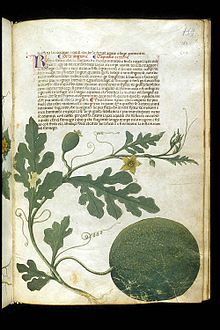Aggregator (pseudo-serapion)
The aggregator ( Pseudo-Serapion ), also Liber aggregatus in medicinis simplicibus , is a medicine theory written by Ibn Wafid in the 11th century, probably in Toledo (“Tortosa”). It was erroneously attributed to Yūhannā Ibn Sarābiyūn , Latinized to Johannes Serapion (junior), an Arabic author from the 9th century. Simon of Genoa translated the work into Latin around 1290 with the help of the Jew Abraham von Tortosa.
History and content
Ibn Wafid used in his drug handbook Kitāb al-adwiya al-mufrada an Arabic source, the Ǧāmiʿ al-adwiya al-mufrada of Abu Bakr Hāmid ben Samagūn from the 10th century, which in turn was mainly based on the writings of Galen of Pergamon and Pedanios Dioskurides based and which he expanded to include other Arabic sources. Around 1250 the text, which had already been expanded in the 11th century by "Pseudo-Serapion", was anonymously updated again. From this emerged the version by Simon of Genoa and Abraham from Tortosa at the end of the 13th century, which became known as Liber aggregatus in medicinis simplicibus . The Canon of Medicine of Avicenna was not used for the operations.
Two Italian translations from the 14th and 15th centuries have survived (including Ms. Egerton 2020 in Paduan dialect, called Erbario Carrarese before 1404 ), German-language editions (such as the editing by the Zurich “apothecary servant” Hans Minner) since the 15th century .
In the first part of the work, degrees of effectiveness and modes of action are described, the second part contains representations of around 460 individual drugs of plant, animal and mineral origin.
Aftermath
Together with the Circa instans , the aggregator formed the basis for large compilations from the late Middle Ages. a. for the Leipzig drug compendium and the first printed illustrated herbal book , the Garden of Health .
Editions of works and translations
- Octavianus Scotus (Ed.): Serapio: Liber Serapionis de simplici medicina. In: Practica Io. Serapionis dicta breviarum [...]. Bonetus Locatellus Venice 1497 ( digitized version ).
- Pseudo-Serapion: A great Arabic pharmacology. Volume 2: The “Liber aggregatus in medicinis simplicibus” by Pseudo-Serapion from the middle of the 13th century. German translation based on the printed version from 1531 by Jochem Straberger-Schneider. Baden-Baden 2009 (= DWV publications on the history of medicine. Volume 6.2).
- Jochem Straberger-Schneider: Pseudo-Serapion: A great Arabic medicine theory. Deutscher Wissenschaftsverlag, Baden-Baden 2009. ISBN 978-3-8688-8009-0 .
literature
- Johannes Gottfried Mayer : The 'Leipzig drug compendium' (Leipzig, university library, Cod. 1224) and its sources. In: Konrad Goehl , Johannes Gottfried Mayer (Hrsg.): Editions and studies on Latin and German specialist prose of the Middle Ages. Festival ceremony for Gundolf Keil. Königshausen and Neumann, Würzburg 2000. ISBN 3-8260-1851-6 . P. 207 ff.
Web links
- Digital copy of a manuscript from the early 14th century (Harley MS 3745).
- Digital copy of a print from 1531.
- The 'aggregator' (pseudo-serapion) of Ibn Wafid.
Individual evidence
- ↑ Gundolf Keil: "blutken - bloedekijn". Notes on the etiology of the hyposphagma genesis in the 'Pommersfeld Silesian Eye Booklet' (1st third of the 15th century). With an overview of the ophthalmological texts of the German Middle Ages. In: Specialized prose research - Crossing borders. Volume 8/9, 2012/2013, pp. 7–175, here: p. 96 f.
- ↑ Christina Becela-Deller: Ruta graveolens L. A medicinal plant in terms of art and cultural history. (Mathematical and natural scientific dissertation Würzburg 1994) Königshausen & Neumann, Würzburg 1998 (= Würzburg medical-historical research. Volume 65). ISBN 3-8260-1667-X , p. 241.
- ↑ Ursula Schmitz (Ed.): Hans Minner's 'Thesaurus medicaminum'. Pharmaceutical historical studies on an Alemannic drug science of the late Middle Ages. (Mathematical and natural science dissertation Marburg / L.) Würzburg 1974 (= sources and studies on the history of pharmacy. Volume 13).
- ^ Gundolf Keil: Hans Minner. In: François Ledermann (Ed.): Swiss pharmacist biography. Pieces of the mosaic on the history of the Swiss Pharmacists' Association (1843–1993). Festschrift for the 150th anniversary [...]. Bern 1993 (= publications of the Swiss Society for the History of Pharmacy. Volume 12), pp. 244–246.
- ↑ Gundolf Keil (2012/2013), p. 97.
- ↑ Gundolf Keil (2012/20113), p. 118.
